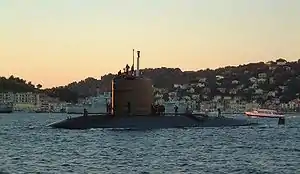French submarine Rubis (S601)
Le Rubis (S 601 ; ex Provence) is a first-generation nuclear attack submarine and head of the Rubis-class series of the French Navy, assigned to the attack nuclear submarine squadron. It was named after the older French submarine Rubis, which gained renown during World War II.
 | |
| History | |
|---|---|
| Namesake: | Ruby |
| Laid down: | 11 December 1976 |
| Launched: | 7 July 1979 |
| Christened: | as Provence |
| Commissioned: | 23 February 1983 |
| Renamed: | renamed Rubis in 1993 |
| Homeport: | Toulon |
| Fate: | In active service |
| General characteristics | |
| Class and type: | Rubis class submarine |
| Displacement: | 2600 t (2400 t surfaced) |
| Length: | 73.6 m (241 ft) |
| Beam: | 7.6 m (25 ft) |
| Draught: | 6.4 m (21 ft) |
| Propulsion: |
|
| Speed: | over 25 knots (46 km/h) |
| Range: | - |
| Endurance: | 45 days |
| Test depth: | over 300 m |
| Complement: |
|
| Sensors and processing systems: |
|
| Electronic warfare & decoys: | ARUR 16 |
| Armament: | |
Construction
The submarine was originally namesaked Provence and was renamed Rubis on 18 December 1980. Being the lead ship of the class, fine-tuning was long, notably needing over 1,000 hours of underwater testing before commissioning. Rubis was fielded on December 11, 1976 and launched on July 7, 1979.
Active service
The Rubis commenced active service on February 23, 1983.
In 1985 she evacuated three DGSE agents who sailed to New Zealand on the yacht Ouvéa to participate in the bombing of Rainbow Warrior, then scuttled their yacht.
Later in 1991, the Rubis formed part of the French naval contribution to the Gulf War. Between September 1992 and July 1993, Rubis undertook a major refitting which upgraded her to the level of the Améthyste. Soon after, on 17 July 1993, the Rubis collided with the tanker Lyria, as the Rubis was surfacing, causing minor damages and injuries.
The Rubis also took part in Operation Trident, the 1999 bombing campaign over Yugoslavia, by protecting the aeronaval group. Along with the Améthyste, the boat was one of the two submarines who interdicted the Kotor straits to the Serbian Navy, thus effectively forbidding its use. The boat also gathered information for the coalition.
In 2002, the Rubis protected Task Force 473 in the Indian Ocean, during Operation Hercules, the naval part of the invasion of Afghanistan.
On 18 July 1996, the fourragère of the Ordre de la Libération was awarded to the submarine and the crew, as a legacy of the Rubis of the Second World War, which had been awarded the medal.
On 30 March 2007, while submerged, Rubis hit the bottom, damaging her bow and sonar. The boat returned to operations in July 2008.[2]
Rubis was expected to be decommissioned in the beginning of 2017 but underwent modernization and has returned to service as of 2019.[3]
Decorations
Since June 5, 2012, the fanion of Rubis was decorated with the Cross for Military Valour with one palm.
 tampion of the Rubis
tampion of the Rubis
See also
References and notes
- Sous-marin nucléaire d'attaque Rubis Archived 2014-10-24 at the Wayback Machine, netmarine.net
- (in French) Déconstruction : le SNA « Rubis » attendu début 2017 à Cherbourg, le marin.fr
